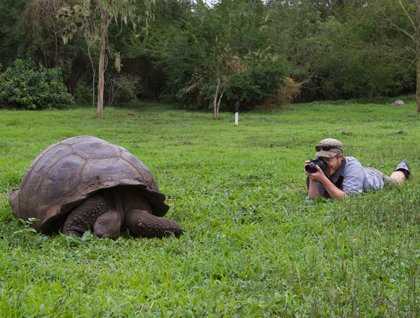After plying eastward overnight from Santiago Island, we awoke this morning in Academy Bay offshore from Puerto Ayora on the Island of Santa Cruz. Following our days exploring the unpopulated environments of the Galapagos, the sights and sounds of ship engines, local music, shopkeepers, and Galapagueños carrying on with their everyday lives struck a sharp contrast and led us to focus more closely upon the human story that has unfolded and continues to unfold here on the islands.
Our adventures began as our Zodiac cut through the morning light in route to Puerto Ayora. This is the research and tourism hub of the islands, as well as home to a majority of Galapagos residents--including so many of the wonderful staff of the National Geographic Endeavor. Once on dry land, we ventured to the Charles Darwin Research Station, an organization that has worked tirelessly to advocate for conservation, to combat the perilous spread of invasive species, and to save the iconic giant tortoises from the brink of extinction. A meandering cobblestone walk, a visit to the open-air fish market (ringed with pelicans, iguanas and sea lions) and a highland-bound bus ride later, we arrived at the Tomas de Berlanga School. As this expedition’s two Grosvenor Teacher Fellows, we had been happily anticipating the visit to this conservation-minded school sponsored and supported by Lindblad Expeditions. After a visit with the students and teachers, we left happily convinced that the spirit and ethos of conservation is alive and well in the next generation of Galapagueños.
Fueled by a delicious lunch from the local restaurant, Aquelarre, we struck out through the welcome lush of the highlands into the land of the tortoise. We found these giant reptiles by the dozen spread about in fields and forest like boulders, moving only slightly faster as they plodded along in their seasonal migration. You may hear of the Galapagos giant tortoises or you may watch them in documentaries, but nothing prepares you for the opportunity to lay belly-down in the pasture eye to eye with them as they eat grass, shift their grand bodies, eat some more grass, and remind you to slow down.







